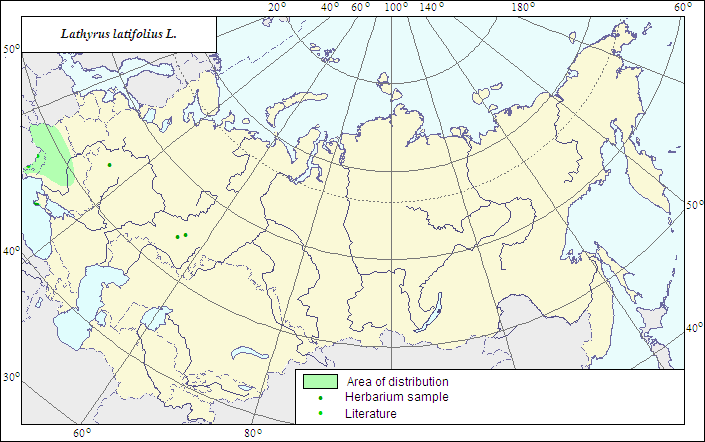Relatives
ange of distribution of Lathyrus latifolius L. (Broad-leaved Everlasting Pea)
 Object description Download GIS-layers
Object description Download GIS-layers
Authors:
The expert-botanist - T.N.Smekalova,the GIS expert - G.V.Talovina.
Date of creation:
18.04.2007Scale:
1:20 000 000.Accuracy of the map:
The map is based on data of a 1:80 000 000 scale map, corrected according to herbarium materials.Projection:
"Albers Equal-Area Conic Projection for USSR", 9, 1001, 7, 100, 0, 44, 68, 0, 0Basic contents:
The map is a vector file consisting of a polygon and dots. Point localities of the species are represented by dots, the area of possible species distribution is represented by the polygon.Accuracy of the qualifier:
Dark dots represent information on the species localities from herbarium specimens, the rest (light) dots represent data from published sources; the polygon is based on generalized information from published sources and herbarium specimens.Method of the map construction:
L. latifolius is a European species distributed in the Central and Atlantic Europe, and in Mediterranean. The northeastern part of the species range is situated in the former USSR. We follow the view of Z.V.Chefranova (Fedorov, Tzvelev, 1987) on the species distribution in the former USSR, and consider the species distributed in the western part of the studied area (Carpathian, Dnieper floristic regions, and Moldova) and in Crimea (in deciduous forests, glades and fringes). The species is not cited in the flora of the middle zone of European part of Russia (Mayevsky, 2006). The species range is represented in the map by two polygons, West European and Crimean. The eastern border of the West European polygon covers the Dnieper River basin, the southern one reaches steppe zone, the northern one is limited by the Upper Dnieper (northern Ukraine). The western border of the polygon runs along the former border of the USSR. The Crimean polygon embraces the species localities in the southern, montane part of the Crimean Peninsula. Separate dots show solitary localities of the species beyond the polygon borders: the species plants are very ornamental and often grown in inhabited places. To note, the species is often confused with the close L. sylvestris - plants of these species differ in leaflet width, flower size and color. The range is based on herbarium collections of LE and MW, and a published map of the species range (Hulten, Fries, 1986).References:
Mayevsky PF. 2006. Flora of the middle zone of European part of Russia. 10th ed. Moscow. P.336-338. (In Russian).Fedorov AA., Tzvelev NN., eds. 1987. Flora of the European part of the USSR. V.6. Leningrad: Nauka. P.151-153. (In Russian).
Shishkin BK., Bobrov EG., ed. 1948. Flora URSS. V.13. P.491-492. (In Russian).
Cherepanov SK. 1995. Vascular plants of Russia and adjacent states (the former USSR). St.Petersburg. 990 p. (In Russian).
Hulten E., Fries M. 1986. Atlas of North European vascular plants north of the Tropic of Cancer. V.1-3. Konigstein: Koeltz Scientific Books. 1172 p.
Herbarium materials of V.L.Komarov Botanical institute [LE], St.Petersburg, M.V.Lomonosov Moscow State University [MW], Moscow (both in Russia).

